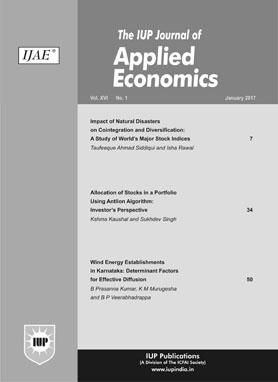
Aug'19
The IUP Journal of Marketing Management
Archives
Case Study
Tata Zica to Tata Tiago: Digital Marketing Strategy of Tata Motors for Rebranding
B Shafiulla
Faculty, IBS Business School, Bangalore #231, Baba Sabara Palya, Near Kengeri Check Post, Kengeri,
Bangalore 560 060, Karnataka, India. E-mail: baranshafi@rediffmail.com, Shafiulla@ibsindia.org
Tata Motors Limited first unveiled the stylish, dynamic and cool hatchback Tata Zica (acronym derived from zippy car) in December 2015 under the new Tata Personalization program. Tata Zica made its first appearance in February 2016 Auto Expo. Tata Motors promoted “Tata Zica” for more than two months before the mosquito-borne Zika virus breakout, mainly affecting Brazil and other parts of South and North America. Tata Motors was then in a dilemma whether to continue with “Tata Zica” brand name or to go for rebranding of “Tata Zica”. This case study is an attempt to understand the strategy behind brand name selection and its association with various marketing strategies. Also, the study highlights the challenges faced by Tata Motors to their rebranding strategies used for its Tata Tiago brand and digital marketing and integrated marketing strategies associated with this rebranding exercise.
Introduction
Tata Motors Limited first unveiled the stylish, dynamic and cool hatchback Tata Zica
(acronym derived from zippy car) in December 2015 under the new Tata Personalization
program. Tata Zica made its first appearance in February 2016 Auto Expo. Tata Motors
launched an innovative digital and on-ground campaign “The #Fantastico Hunt”to
create buzz about the name of its new car—the yet-to-be launched Tata Zica. Tata
Motors promoted “Tata Zica” for more than two months before the mosquito-borne
Zika virus breakout, mainly affecting Brazil and other parts of South and North America.
The Zika virus infection has been linked to thousands of babies being born with
underdeveloped brain called microcephaly. The World Health Organization (WHO)
has declared Zika virus a global health emergency. Tata Motors decided to change the
brand name “Zica”. Tata Motors was now in a dilemma whether to continue with “Tata
Zica” brand name or to go for rebranding of “Tata Zica”.
To do this, Tata Motors announced the “#Fantastico Name Hunt”, a global crowdsourcing
competition for all netizens to suggest a new brand name for its cool hatchback
“Tata Zica”. Contestants got to vote for a preferred new name from a shortlist of three
suggested names: (1) Adore, (2) Civet and (3) Tiago. At the end of the competition, the
results of the voting were unveiled and the Zica finally got its new brand name “Tiago”
(a Portuguese boy’s name). This case study intends to understand the branding strategies
of Tata Motors for passenger cars and the factors to be considered while making brand
decision.
Background
The Indian auto industry is one of the largest in the world. Auto industry in India accounts for 7.1% of India’s Gross Domestic Product (GDP). The overall Passenger Vehicle (PV) segment accounts for 13% market share (Exhibit 1). The two-wheeler (TW) segment with 81% market share is the leader of the Indian automobile market owing to growing demand from the middle-class segment, rural customers and young population. The Indian automobile industry produced a total of 25,316,044 vehicles, which included passenger vehicles, commercial vehicles, three-wheelers, two-wheelers and quadricycle in 2016-2017 as against 24,016,599 in 2015-2016, registering a growth of 5.41% over the previous year.1
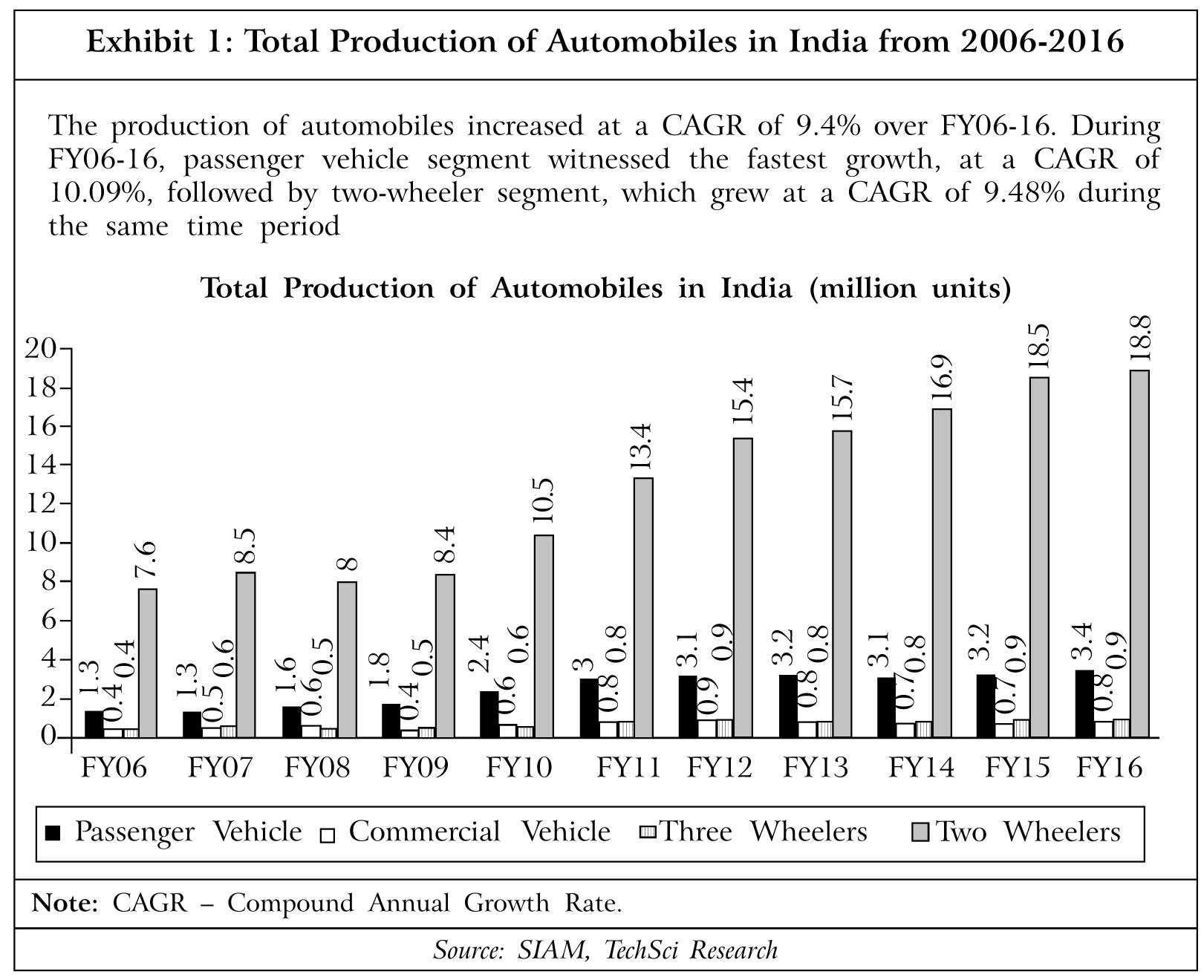
The sale of passenger vehicles grew by 9.23% in 2016-2017 (Exhibits 2 and 3) over the previous year. Passenger cars, utility vehicles and vans grew by 3.85%, 29.91% and 2.37% respectively during 2016-2017 within passenger vehicles segment. The overall commercial vehicles segment registered a growth of 4.16% in 2016-2017 as compared to the previous year. Medium and Heavy Commercial Vehicles (M&HCVs) grew by
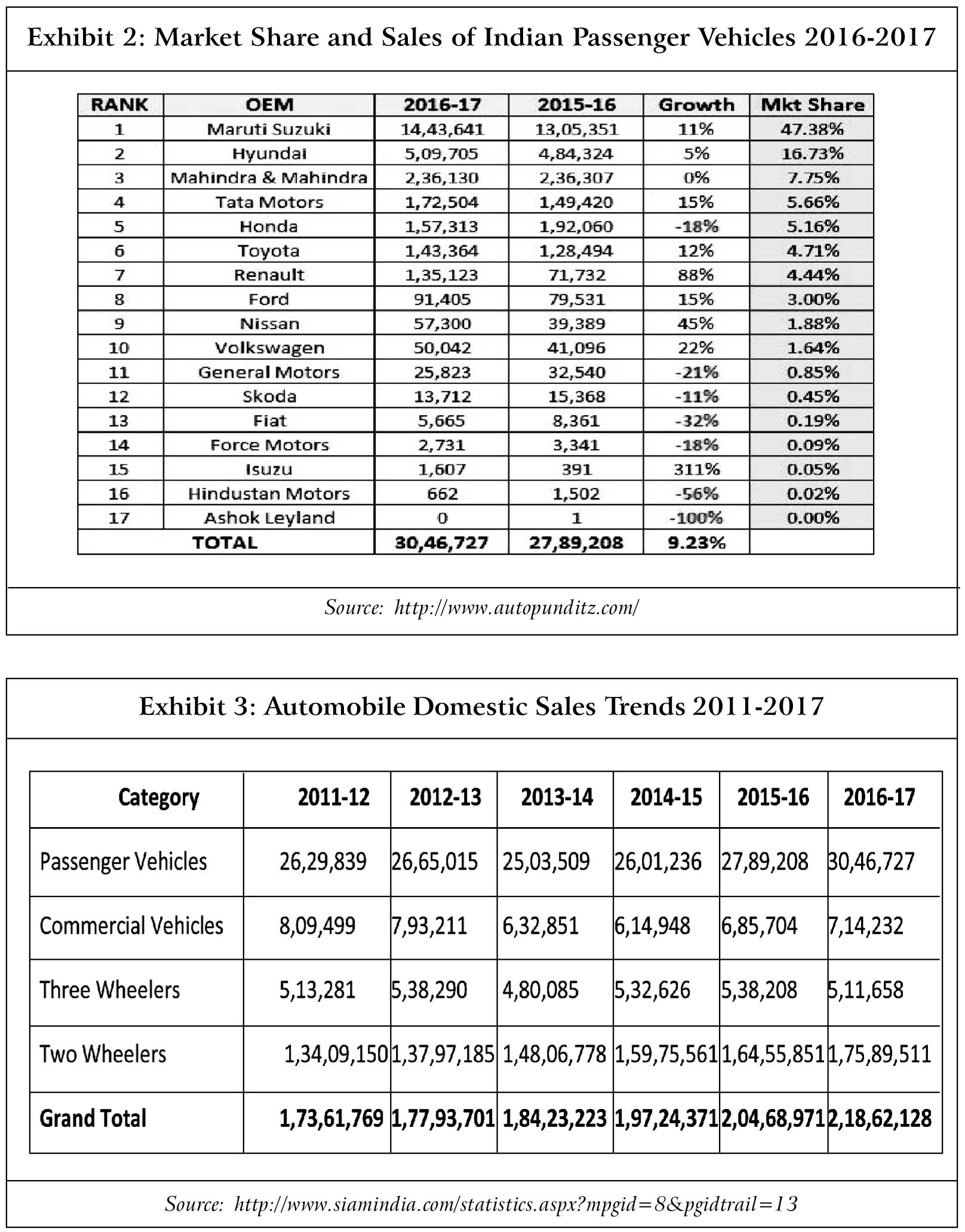
0.04% and light commercial vehicles grew 7.41% during 2016-2017 over the same period
the previous year. Three-wheeler sales declined by (–) 4.93% in 2016-2017 and passenger
carrier sales declined by (–) 8.83% in 2016-2017 over the same period the previous year.
The Goods Carrier (GC) sales grew by 12.75% in 2016-2017 over 2015-2016.
Two-wheeler sales registered a growth at 6.89% (Exhibit 4) and within the twowheeler
segment, scooters, motorcycles, and mopeds grew by 11.39%, 3.68% and 23.02%
respectively in 2016-2017 over 2015-2016.
Overall automobile exports in 2016-2017 (Exhibit 5) declined by (–) 4.50%, while
passenger vehicles and commercial vehicles exports registered a growth of 16.20% and
4.99% respectively, and exports of three-wheelers and two-wheelers declined by (–) 32.77%
and (–) 5.78% respectively in 2015-2016.3
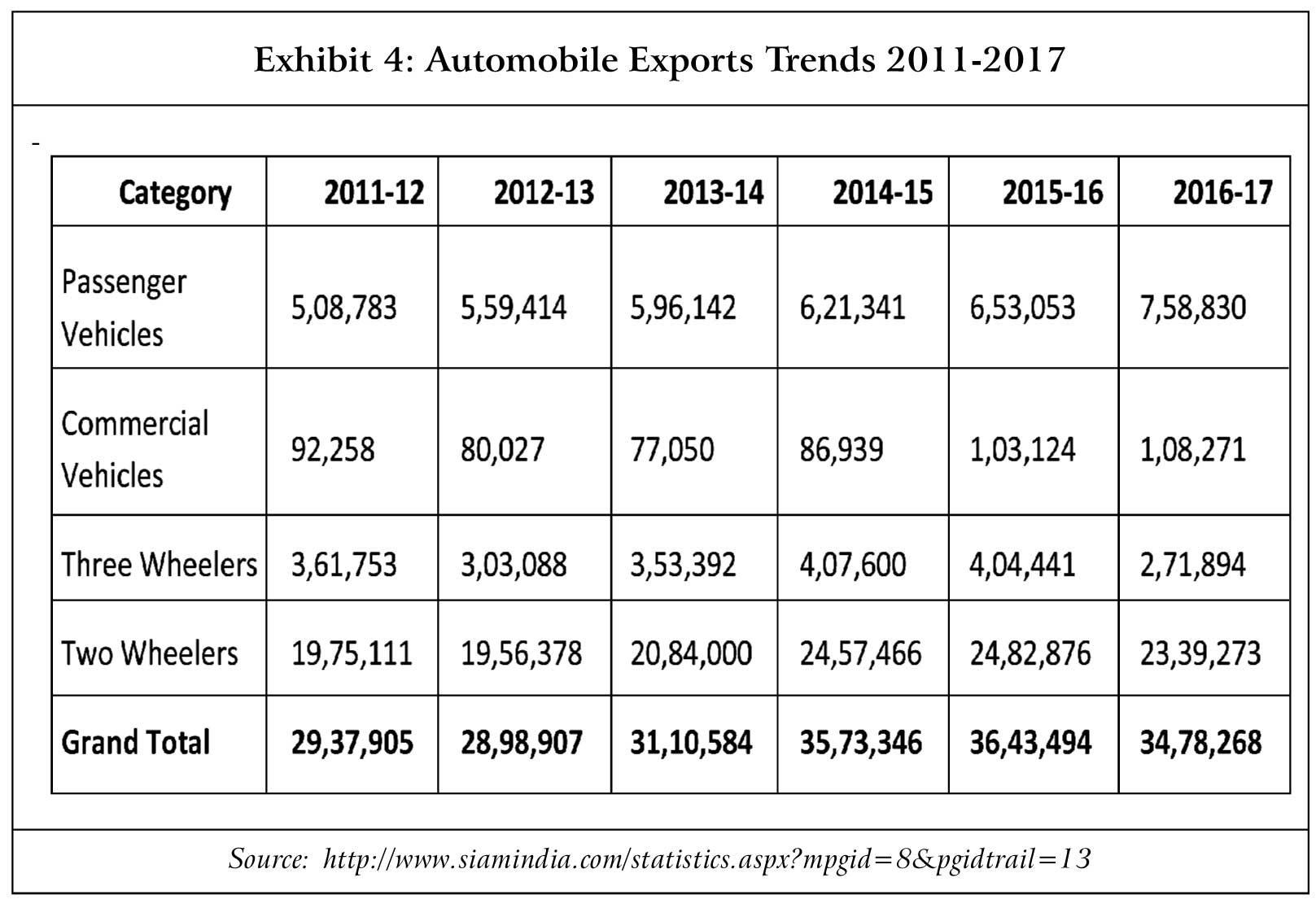
Several initiatives by the Government of India and major automobile manufacturers in the Indian market are expected to make India a leader in two-wheeler (2W) and four-wheeler (4W) market in the world by 2020. Young Key Koo, managing director, Hyundai Motors India Limited, has stated that India is a key market for Hyundai Motors, not only in terms of volume but also as a hub of small products for exports to 92 countries. Exhibit 5 represents the growth rate of automobile for the year 2011 to 2017.

Joachim Dress, Global CEO, MAN Trucks and Bus AG, has stated that India has the potential to be among the top five markets, outside Europe, by 2020 for the company, which reflected in the appointment of its most experienced managers in India for increasing volumes and exports out of India.4 The India automotive aftermarket is estimated to grow at around 10-15% to reach $16.5 bn by 2021 from around $7 bn in 2016. Indian automotive industry has the potential to generate up to $300 bn in annual revenue by the year 2026, which may create 65 million jobs and contribute over 12% to India’s GDP.
Tata Motors Limited: An Overview
Tata Motors is part of the $100 bn Tata Group founded by Jamsetji Nusserwanji Tata in 1868. Tata Motors Limited is a leading global automobile manufacturer established in 1945. Tata Motors logo went international in 1961. Currently, present in over 175 countries around the globe with a market value of $42 bn, Tata Motors has a product portfolio of cars, sports vehicles, buses, trucks and defense vehicles with total sales of nine million till 2017. Tata Motors Limited’s cars, buses and trucks roll out from 20 locations across the world—seven in India and the rest in the UK, South Korea and Indonesia. Tata Motors Limited has built a strong global network of subsidiaries and associated companies, including Jaguar Land Rover in the UK and Tata Daewoo in South Korea. Tata Motors is also engaged in engineering and automotive solutions.5
Objective
This study is carried out with the following objectives:
- To understand the branding strategies of Tata Motors for passenger cars and factors to be considered while making brand decision.
- To debate and discuss “#Fantastico Hunt”, the digital marketing strategy of Tata Motors to create buzz marketing for Tata Zica before its launch.
- To discuss and debate whether Tata Motors should continue with “Tata Zica” brand name or go for rebranding for its hatchback car “Tata Zica”.
- To know the strategy behind “#Fantastico Name Hunt” global crowd sourcing competition for rebranding of Tata Zica and its impact on Tata Tiago brand positioning and customer engagement with the new brand.
- To understand and analyze integrated marketing strategies and digital marketing strategies of Tata Motors for Tata Tiago and suggest new or innovative digital marketing and integrated marketing strategies.
- To understand and debate the selection of Lionel Messi as the global brand ambassador of Tata Tiago instead of choosing Indian celebrities.
- To know the challenges faced by Tata Motors for rebranding Tata Zica and to know how a disease with a similar name can have an impact on the brand name of a passenger car.
Launch of Tata Zica
Tata Motors Limited first unveiled its stylish, dynamic and cool hatchback Tata Zica6 in
December 2015 under the new Tata Personalization program (Exhibit 6). Tata Zica has two
engine options; an all new 67 bhp 1.05 L, 3-cylinder Revotorq diesel motor and
83 bhp 1.2 L, 3-cylinder Revotron petrol unit, as in the Zest and the Bolt. Transmission
option includes a 5-speed manual gear box and an AMT (Automated Manual Transmission).7
Tata Zica has a City and an Eco mode that results in stunning performance and fuel efficiency.
Zica is also equipped with a Harman-developed ConnectNext infotainment system, Jukecar
app and first-in-segment smartphone-enabled navigation app to guide the trip.
Tata Zica made its first appearance in February 4-9, 2016 Auto Expo held at National
Capital Region, New Delhi (Exhibit 6). Tata Zica is backed by Tata Motors’ “Made of
Great” campaign to relate its association with Lionel Messi,8 with the motto, “what
drives us from within is what makes us great”. Tata Motors is committed to doing what

is right for its customers; the car, which has been designed for young people, has received
enthusiastic reviews from informed commentators.
“The #Fantastico Hunt” for Tata Zica Brand Promotion: Tata Motors launched an
innovative digital and on-ground campaign called “The#Fantastico Hunt”
(Exhibits 7a and 7b) to create a buzz about the name of its new car Tata Zica which was
due for launch in February 2016. The campaign was jointly executed by Wizcraft on
ground and DigitasLBi on digital, spread across four metros – Mumbai, Delhi, Bengaluru
and Kolkata. Through this campaign, Tata Motors invited eager fans to collectively
unveil the brand name through a series of strategically placed clues around each city.
From trendy spots like Mumbai’s first Starbucks that featured as the place that is
“World-famous for its #Fantastico Pumpkin Spice Latte” to Delhi’s most happening
places at Hauz Khas9 Village. Clues had fans searching across the cities till they discovered
their letter. Each hidden letter formed the name of the new car ‘Zica’. While some
fans stayed glued to their screens cracking clues and awaiting updates, others swarmed
the streets to find the next destination—a collective effort that ended with fans capturing
selfies with their city’s letter glittering in the background at popular city spots. Fans
had been actively engaged on Twitter and other social media channels and handed
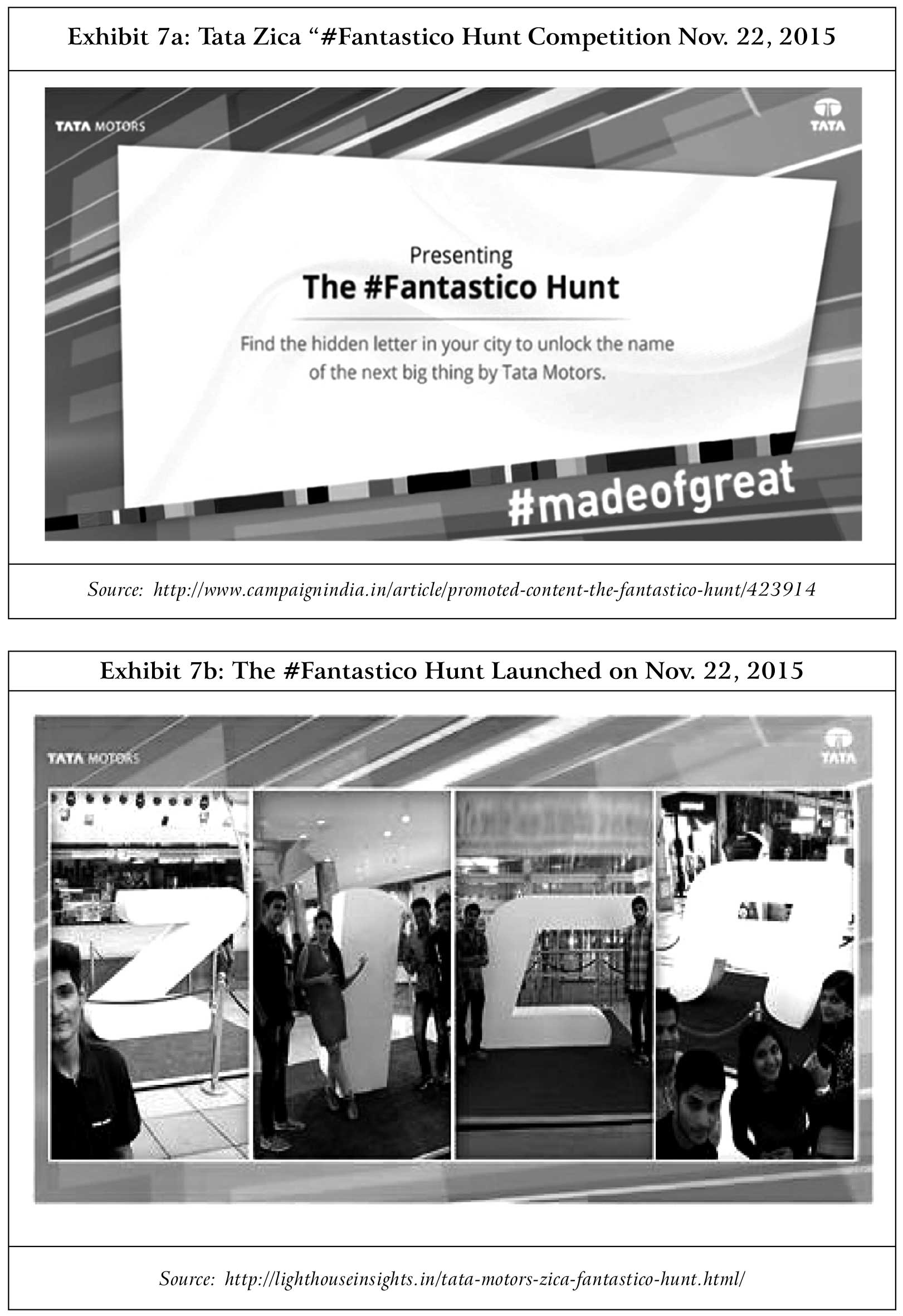
clues to the locations of the letters and followed the progress through a series of updates
from the “#madeofgreat” brand web page.10 On-ground volunteers and supporters
from the brand helped kick things off. The entire campaign was themed and positioned
as “The #Fantastico Hunt” to tie in with the new car’s positioning—“It’s
#Fantastico”.11 Winners who found their city’s letter first were presented cool, branded
merchandize. Rather than just reveal the brand name of the car, Tata Motors wanted
to get the audience involved in discovering it, while sharing a sneak peak of its
communication thought—“It’s #Fantastico”—the brand positioning of Tata Zica.
“Fantastico hunt” campaign resulted in 150 million impressions and 45,469 mentions
online.
“It takes a lot of courage to come up with an innovative idea and a whole lot of
conviction to follow it through! Another ‘first’ under the “Made of Great” partnership;
Having only 24 hours to collaborate digitally and execute on-ground, the team did a
phenomenal job on the ‘The#FantasticoHunt’ and the impact was felt nationally as
well as internationally.” – Sandeep Mehta, Vice President, Wizcraft International
Entertainment.
“Rather than just reveal the name of the car, our attempt, was to get the audience
involved in discovering it, while sharing a sneak peek of its communication thought—
‘Its #Fantastico’. Social media works brilliantly when combined with real world
experiences, and that really added the edge to this activity,” said Amaresh Godbole,
Managing Director, DigitasLBi India.14
Outbreak of Zika Virus:
The Zika virus had caused panic in Brazil since it first appeared in May 2015 (Exhibit 8). More than 2,100 babies in Brazil were born with microcephaly or other birth defects linked to Zika virus. Brazil and several other nations had advised women to postpone pregnancy. Those affected among babies were said to suffer from congenital Zika syndrome. As of February 21, 2016, the Center for Disease Control and Prevention (CDC) had confirmed Zika infections in more than 1,500 pregnant women in the US and more than 3,200 pregnant women in US territories. Forty-seven US babies have been born with Zika-linked birth defects, and five pregnancy losses have been linked to the virus.

The Zika virus, first identified in 1947, is transmitted by Aedes mosquitoes, the same
type of mosquito that carries Dengue fever, Yellow fever, and Chikungunya virus. A mosquito
bites an infected person and then passes those viruses to other healthy people it bites.
Outbreak did not occur outside Africa until 2007, and then it spread to the South Pacific.
The Zika virus causes birth defects in babies born to some infected pregnant women,
including microcephaly (Exhibit 9), where babies are born with underdeveloped head
and brain damage. Zika had “never been thought of as a severe infectious disease until
now,” said Amesh Adalja, MD, a spokesperson for Infectious Disease Society of America.
The CDC had confirmed Zika can spread through sex, usually after a person traveled to
an area where Zika had broken out, got the virus, and gave the virus to the partner who
did not travel. Some studies have shown that the Zika virus can be found in blood,
semen, urine and saliva of infected people, as well as in fluids in the eyes. The Zika
disease can cause fever, rash, joint pain and redness in the whites of the eyes (conjunctivitis).
Only one out of five people with the Zika virus exhibits symptoms.
The World Health Organization (WHO) had declared Zika virus a global health
emergency. Some areas had declared a state of emergency; doctors described it as “a
pandemic in progress”. Unlike Ebola,17 where the focus was on boots on the ground,
with Zika the attention was on understanding the link with microcephaly. It would also
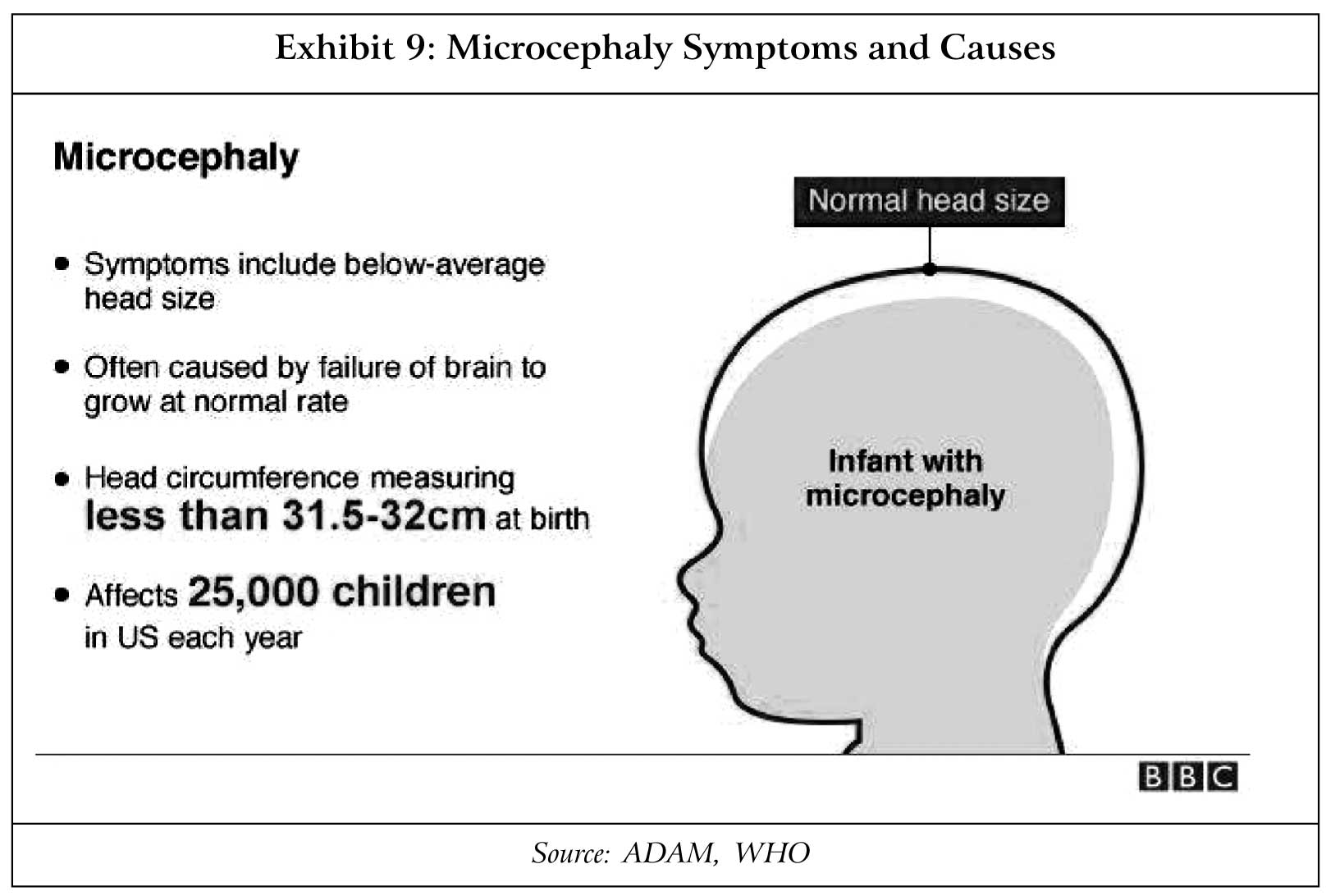
encourage efforts to wipe out mosquitos that spread the disease as well as finding a
treatment or a vaccine to stop the Zika virus.
In November 2015, “Zica” brand name was announced by Tata Motors and set for
launch by March, 2016. The new brand name “Zica” faced a brand name crisis after
the outbreak of Zika virus in January 2016. With only two months to go for the launch
of the hatchback’s rollout, Tata Motors had to come up with a new name within a short
span of time. Tata Motors had promoted the “Tata Zica” through online social media,
YouTube videos, print advertisements in newspapers, auto magazines, billboards and
television advertisements for more than two months before the mosquito-borne Zika
virus breakout, mainly affecting Brazil and other parts of South and North America.
The car was an important product for Tata Motors and the carmaker did not want to
proceed with a controversial name that could potentially result in bad publicity and
adversely affect the sales and brand image of Tata Motors.
Rebranding of Tata Zica Through “Fantastico Name Hunt” Campaign
Tata Motors decided to change the brand name “Zica” on February 2, 2016. To do this,
Tata Motors announced the “#Fantastico Name Hunt”, a global crowd-sourcing
competition for all netizens to suggest a new brand name for its cool hatchback “Tata
Zica”. Contestants got to vote for a preferred new name from a shortlist of three suggested
names: (1) Adore, (2) Civet, and (3) Tiago. While it carried the “Zica” label for the
duration of Auto Expo February 2016, in Greater Noida, New Delhi, the new name
was announced after a few weeks, ensuring all necessary consumer/branding and
regulatory aspects were addressed for the final launch.
The “#Fantastico Name Hunt” contest was conducted online on social media and
mobile platform with entries accepted via SMS and WhatsApp, making it easier for the
target audience to share their nominations. The “#FantasticoNameHunt” contest
commenced on February 4, 2016 and ended on February 7, 2016 at 23:59 IST. It was
hosted on Tiago from Tata Motors Facebook and Twitter accounts. Contestants could
share their entries via SMS or WhatsApp (SMS
The main objective of the “#FantasticoNameHunt” contest was to look forward to
launching more such innovative campaigns and engaging initiatives to ensure enhanced
customer participation and engagement. Tata Motors collected all entries and suggestions
from its fans and audience the world over. The hunt for the new name ended on
February 7, 2016. The company further shortlisted these entries for viewers to vote for
their favorite name. One of the lucky winners, whose selection matched the final name,
stood a chance to win the car (in India) or win a cash reward of equal value of the car
(located outside India).
The “#FantasticoNameHunt”20 campaign was created by Maxus (of GroupM) for
Tata’s new car Zica, and just three weeks before the launch, the WHO declared Zika,
the virus, as a global emergency. Consumers started associating Zica, the car with the
virus Zika, and it was becoming a great threat to the brand image. Maxus conceptualized,
created and implemented a 3-stage approach to overcome the challenge and launched
the “The#FantasticoNameHunt” campaign. In just three days, the campaign reached
48 million impressions through Facebook, 2.2 lakh engagements on Twitter and 1.2
crore video views across 22 target markets. 37,000 names/proposals were submitted
generating over 5,500 unique names, including names like Pihu, Spry, Afford, Diamond,
Zeest, Zeus, Tacar, Superno and Excitica. This campaign garnered $410,000 of earned
media coverage along the way. The name had to be 5-6 letters long. After eliminating
the duplications, a team of 10 went through the names to understand which could
capture the characteristics of the car. They created a list of 25 names each, from which
the company had to identify words that are not inappropriate in major languages. A
global agency hired by Tata Motors carried out the linguistic checks. Three names—
Civet, Tiago and Adore—made it to the final shortlist. These final three names were put
on to vote on the social media.
Google searches for ‘Zica’ totally dropped and ‘Tiago’ surged, showing that the
consumers were on board with the change. Maxus bagged Grand Prix at the World
Media Awards 2017 held at London for their campaign “From Zica to Tiago”. The
campaign also won Gold in automotive category. Within four months of the launch,
Tiago received more than 120,000 test drive requests which were three times more than
for any Tata car launch in the last decade. The basic idea of the “#FantasticoNameHunt”
campaign was to find a new name for the car without sacrificing on the buzz already
created around Tata Zica. Tata Motors managed to create a more personalized connection
between Tiago and its fans through “The #Fantastico Name Hunt” campaign.
Tata Motors managed to create a more passionate and personalized connection
between Zica and its fans. At the end of the competition, the results of the voting were
unveiled and the Zica finally got its new brand name “Tiago”. The Tata Tiago
(Exhibit 10), launched on April 6, 2016 in several markets worldwide, has been endorsed
by soccer great, Lionel Messi, (Exhibit 11) who is the brand’s global ambassador for
Tata Motors’ passenger vehicles portfolio for two years (with option to extend further).
The Argentinean becomes the first brand ambassador of the Tata Motors in its 70 years
history. He plays for Barcelona in the La Liga. Messi was the first player to win three
Golden Shoe awards. For Tata Motors, Messi was to be the “agent of change”, aiming to
reclaim its lost position in the Indian passenger car market by introducing a series of
new products, innovative marketing programs and customer engagement initiatives.
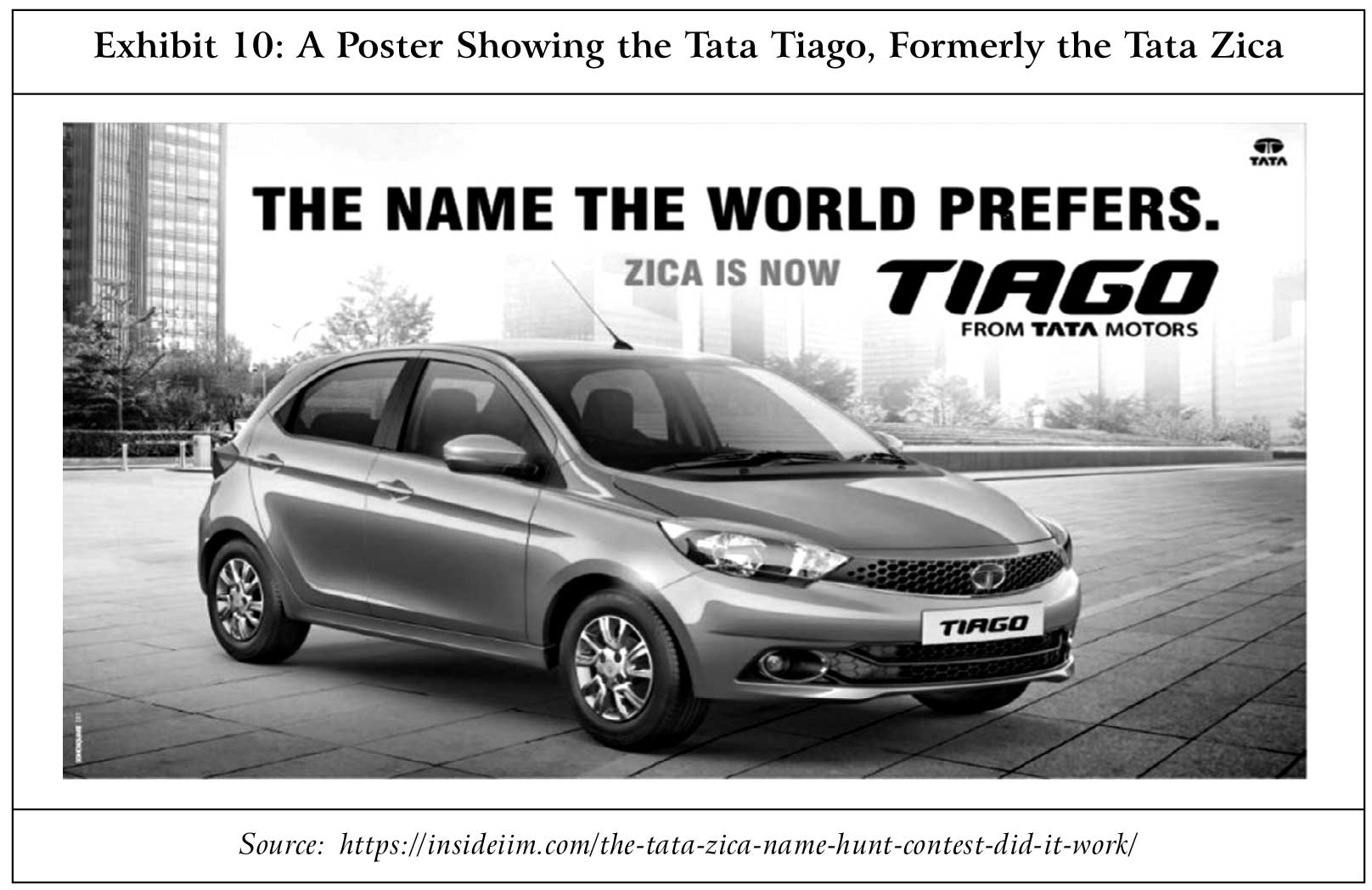
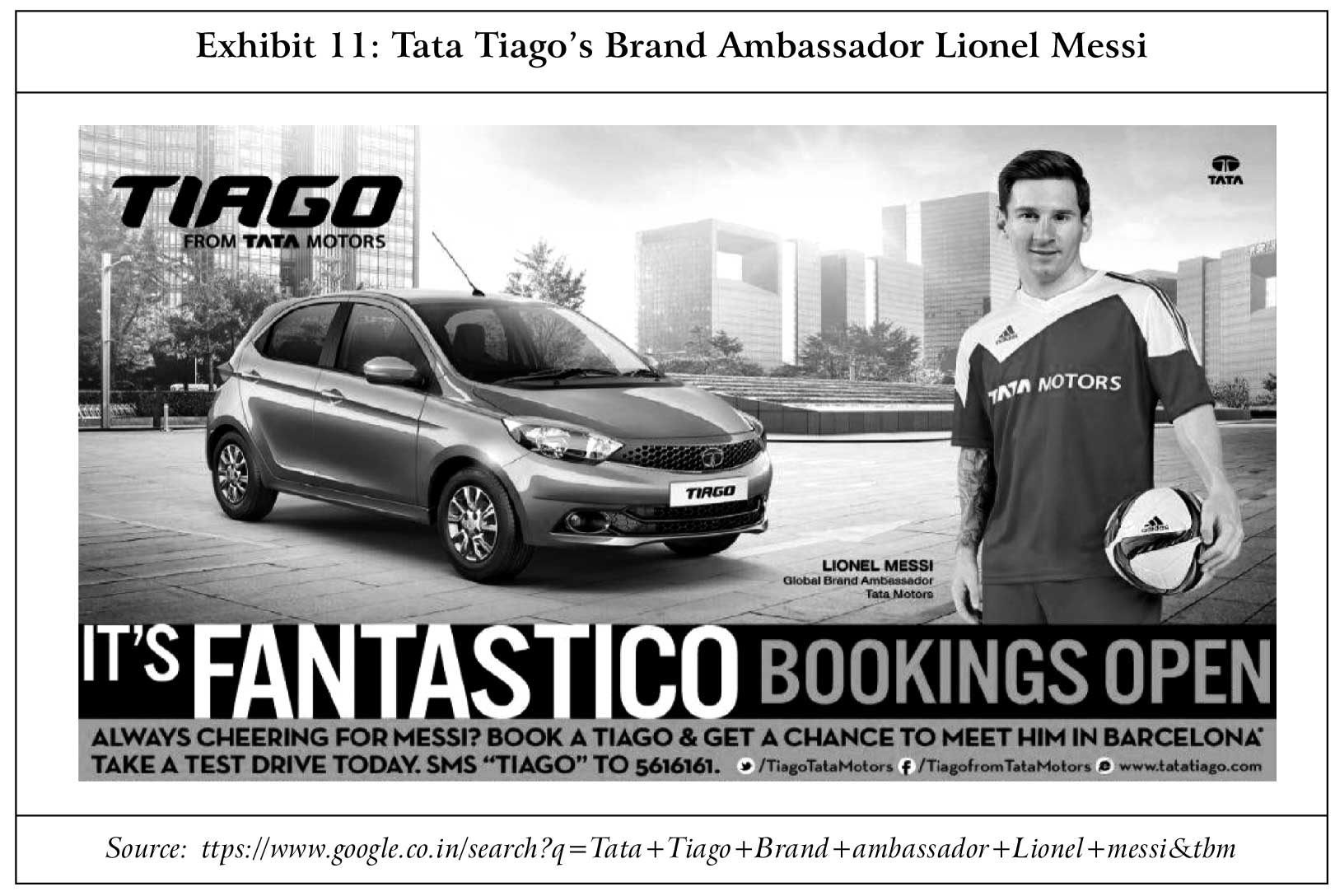
Tata Tiago has five variants (XB, XE, XM, XT, and XZ) with a basic model price of
3.24 lakh and top end model price of 5.67, with six exciting color options to attract
youngsters. It looks fresh and is a substantial improvement on the Indica, which it
will replace in Tata’s line-up. Its major competitors are Maruti Suzuki Celerio, Hyundai
i10 and Ford Figo. In October 2016, Tiago’s sale crossed 6,000 units for the first
time. In January, 2017 Tiago clocked an average monthly sale of 4,500 units, and is
the key product behind the spike in the sales of Tata Motors (Exhibit 12). The current
waiting period for the car is up to three months was up to three months. In February
2017, Tata Motors passenger vehicles, in the domestic market, reported sales at 12,272
units with a growth of 12% over February 2016 (Exhibit 13), due to continued demand
for the Tata Tiago. This includes Tata Motors’ passenger transporters range which
consists of 5-seater mini vans to 81-seater buses. Tata Motors’ passenger vehicles portfolio
includes compact cars, mid-sized sedans, SUVs, utility vehicles, hatchbacks and
crossover cars (Exhibit 14). In addition, Tata Motors’ commercial vehicle portfolio
includes trucks from sub-1 tonne to 49-tonne mass movers. It consists of Ace ZP, Super
Ace, Prime range of trucks and Signa range new multi-utility heavy commercial vehicles
(Exhibit 15).
According to ‘Auto Professional’ reports that sales of the Tata Tiago had crossed the
50,000 units’ sales milestone since the Tata Tiago’s launch on April 6, 2016. This had
helped increase Tata passenger car market share to 6.41% (111,500 units) from 5.44%
(91,648 units) in the April 2016-January 2017 period. The Tiago is also one of Tata
Motors best selling models, the other being Tata Indica.
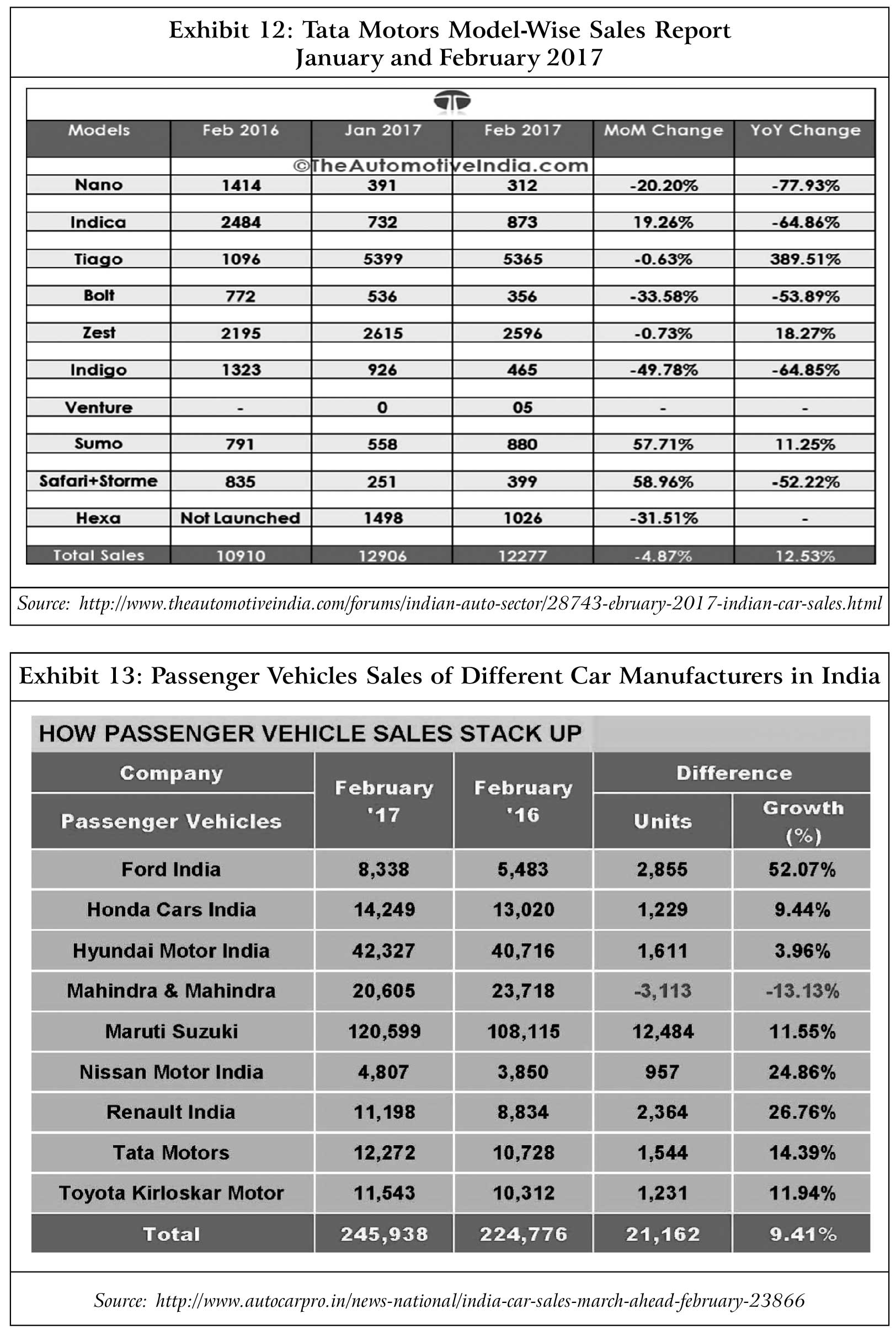
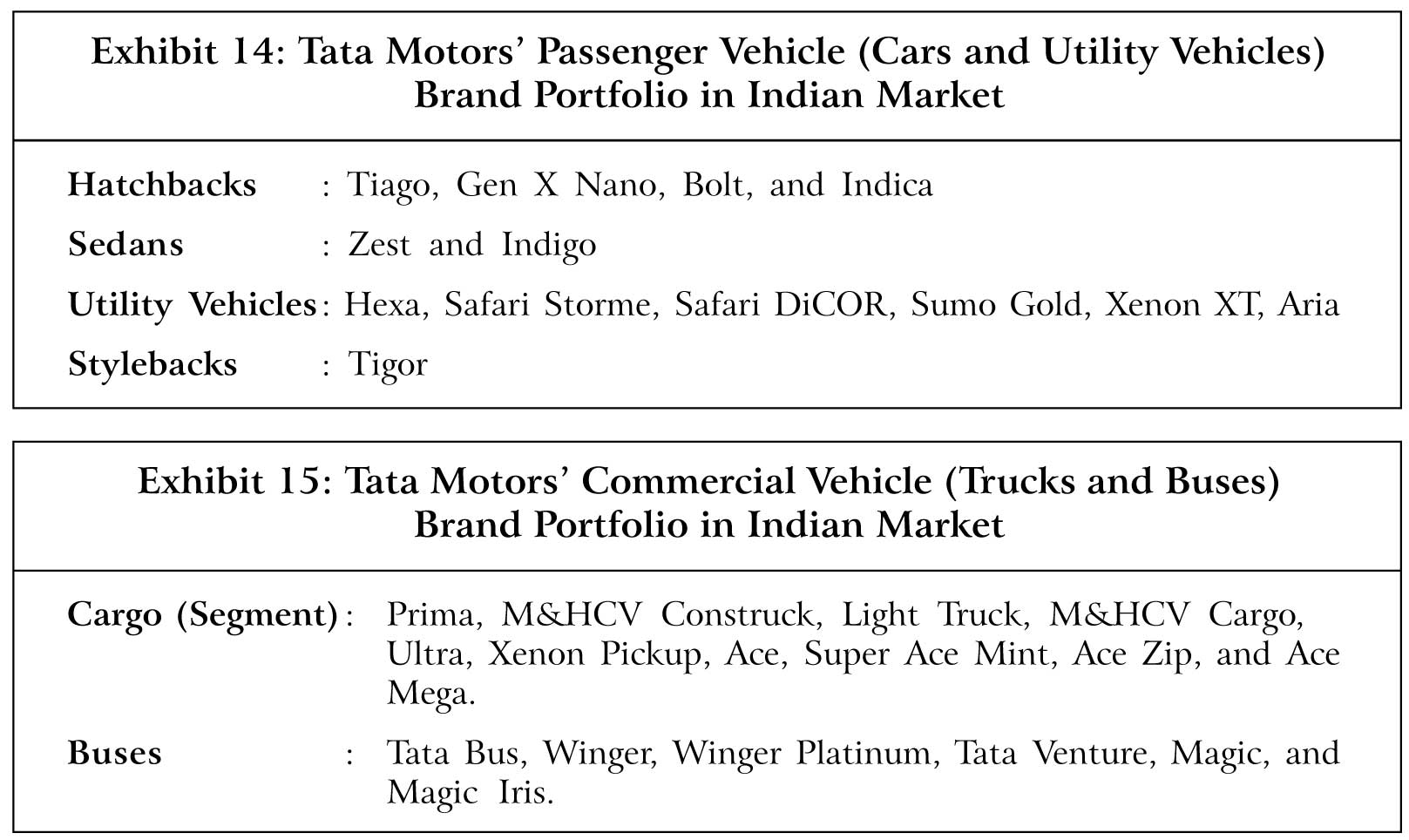
According to N Chandramouli, CEO at brand intelligence firm TRA, “No brand wants to start-off with a wrong name; here Tata Motors has converted a probable problem into an opportunity before it turned into a crisis. This is probably the first time a car manufacturer in India opted for crowd-sourcing to name a new product, even though the idea is not new”.
Analysis of the Case Study
Tata Motors Limited had first unveiled the stylish, dynamic and cool hatchback Tata
Zica (an acronym derived from Zippy Car), in December 2015. Tata Motors had not
done research on the brand name before finalizing the name. The Zika virus was first
identified in 1947 in Africa. This was the basic mistake committed by the brand managers
of Tata Motors as they were not able to find similar existing names to “Zica” and its
meaning, which they could have done online.
The Zika virus had caused panic in Brazil since it first appeared in May 2015 and
spread to the US. The WHO had declared Zika virus a global health emergency. The new
brand name “Zica” faced a brand name disaster, as the meaning of “Zica” a Zippy Car,
now changed to a disease “Zika virus”. Tata Motors was in a dilemma whether to continue
with the same brand name or go for rebranding of “Tata Zica”. Tata Motors could have
continued with the same in the Indian market, as most of the people in India were not yet
aware of the Zika virus. Only for the global market, they considered rebranding of
Tata Zica.
As far as the rebranding strategy was considered, it was left to the expert global
brand managers to decide the new brand name for Tata Zica. They had to analyze
various brand decision parameters to arrive at the final branding decision. The entire
campaign was themed and positioned as “The #Fantastico Hunt” to tie in with the new
car’s positioning—“It’s #Fantastico”. The positioning slogan “The #Fantastico” was
used to attract global customers and its association with global celebrity Lionel Messi.
Tata Motors organized “The #Fantastico Hunt” and “The #Fantastico Name Hunt”
digital marketing campaigns to engage its loyal customers to participate in its branding
decision. “The #Fantastico Hunt” digital marketing campaign was strategically used by
Tata Motors to create enthusiasm and customer engagement towards Tata Zica hatchback.
For rebranding of Tata Zica, Tata Motors brand managers used global crowd sourcing
competition “The #Fantastico Name Hunt” to target all netizens and exploit the buzz
created around Tata Zica. Tata Motors used different digital marketing tools/methods
like search engine marketing, search engine optimization, social media marketing, mobile
marketing, content marketing, and digital display advertising. Tata Motors wanted to
use the same digital media to communicate the change of brand name of “Tata Zica to
Tata Tiago”.
For brand name selection and rebranding, there are many factors which affect the
final brand name selection. But in this case, a disease-causing virus “Zika” has made
Tata Motors rebrand its hatchback “Tata Zica”. Tata Motors was able to do this
transformation from “Tata Zica to Tata Tiago” successfully and very efficiently, which
was demonstrated by its innovative digital marketing campaigns and market demand
for Tata Tiago in the Indian and global market.
Current Trends
Tata Tiago Beats Maruti Celerio, Hyundai Santro in June Sales – WagonR Leads
Maruti WagonR sales in June 2019 declined to 10,228 units. Sales of this recently updated hatchback fell 9.57% from 11,311 units sold in June 2018 (Exhibit 16). The new WagonR
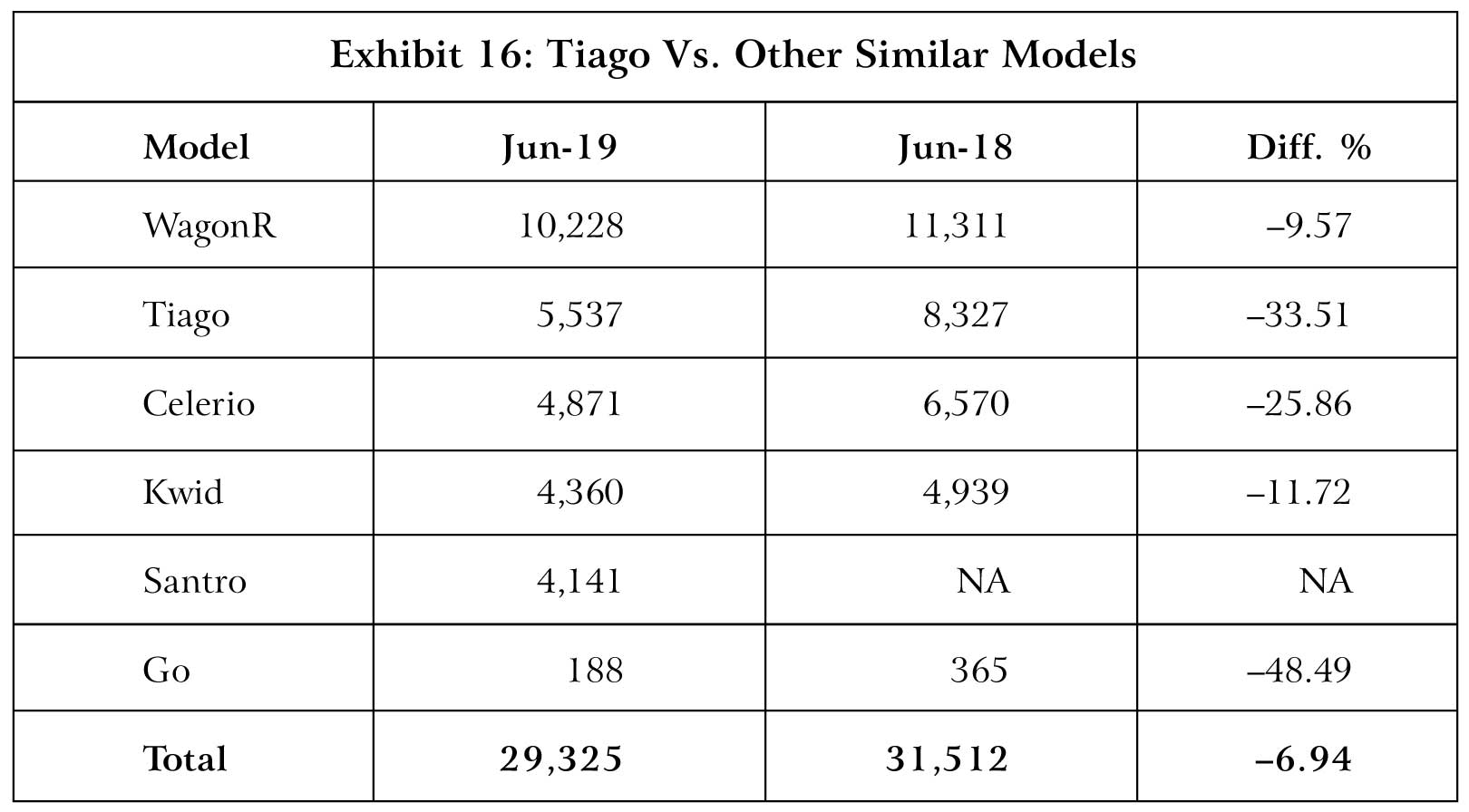
was launched in January 2019 and came in with a completely new design, new platform and
an enhanced engine lineup, and its June update comprises a price hike in line with BSVI
engine compliancy.
At No. 2 on the list is Tata Tiago entry level hatchback segment behind WagonR.
Sales of Tata Tiago fell by 33.51% to 5,537 units in the past month, down from sales of
8,327 units in June 2018. During the month, Tata Motors offered discounts and exchange
schemes to encourage sales. Tiago petrol variants of XE, XM and XZ were offered at
exchange bonus of 10,000 and 1st year insurance. Tiago XZ Plus was offered at a cash
discount of 10,000 and an exchange bonus of 10,000.
Third on the list is another Maruti Suzuki offering. Celerio hatchback sales are down
25.86% to 4,871 units in June 2019, down from 6,570 units sold in the same month of
the previous year. The company is now gearing up for the launch of the new Celerio
during the second half of 2020. Celerio facelift, launched in 2017, is beginning to feel old
and dated. Added pressure from competition has affected sales to a great extent.
Data – Auto Punditz
Renault Kwid sales takes fourth spot on the list after WagonR, Tiago and Celerio.
Renault Kwid, a high selling entry level hatchback for the brand, saw diminished sales
in June 2019. Sales of the Kwid dipped 11.72% to 4,360 units in June 2019, down
from 4,939 units sold in June 2018. Kwid reached the three lakh unit sales milestone in
June 2019. It was updated earlier this year, and now sports safety features which became
mandatory from July 1, 2019.
Hyundai Santro launched in India late last year takes the 5th spot on the list of best
selling small hatchbacks in the country in June 2019. Total sales stood at 4,141 units.
Santro, which was initially a success with the automaker managing to put 50,000 units on
the road in less than six months of launch, has been noting diminishing sales. Monthly sales
of the Santro, which were hovering around the 8,000 unit mark, have now dipped
significantly.
Datsun Go sales slipped 48.49% in June 2019 to 188 units, down from 365 units
sold in June 2018. Datsun GO and GO+ now feature Vehicle Dynamic Control
technology for better safety. Datsun GO range is available in ‘Vivid Blue’ color too.
It can be seen from the above that the month of June 2019 has been a tough month
for the entry level hatchback segment with every car on the list reporting reduced
sales. Not only this segment, but every other segment in the country has also had to
contend with the same negative growth. There is no indication of correcting sales
trends in the months ahead.
Tata Motors Hatchbacks
Overall, Tata Motors’ cumulative sales in the domestic market for the fiscal (April 2019
-July 2019) were at 47,430 units, a drop of 32%, compared to the units sold in the
same period last year. Tata Motors passenger and commercial vehicle sales dipped
34% in July 2019 to 32,938 units as against 50,100 units sold in the same month of
the previous year. Taking into account passenger vehicle sales, the company saw a
39% dip in sales to 10,485 units in July 2019 as against 17,079 units sold in July
2018. Sales were also lower by 21% in the past month as against 13,351 units sold in
June 2019. Tata Tiago sales dipped 41% to 4,689 units in July 2019 as against 8,009
units sold in July 2018. Sales in June 2019 were also higher at 5,537 units, bringing
July 2019 sales lower by 15%. Tata Motors is currently working on a mid-life update
for the Tiago compact hatchback with launch date scheduled for later this year or
early 2020.
Tata Tigor sales fell 55% to 1,014 units in July 2019 as against 2,269 units sold in
the same month of the previous year. Sales were also down 29% in July 2019 as compared
to 1,438 units sold in June 2019. Tata Motors is actively testing the Tigor facelift with
a BS VI compliant engine, which will cost marginally more than its current counterpart.
Tata Harrier, which entered the segment earlier this year, has been facing stiff competition
from the MG Hector. Sales in the past month stood at 740 units, down 39% from 1,216
units sold in June 2019. In June 2019, the company also hiked prices of the Harrier
premium SUV by 30,000, bringing in new dual tone color options of Calisto Copper
with black roof and Orcus White with black roof.
Sales of the Tata Nexon which stood at 3,840 units in July 2018, fell 13% in July
2019 to 3,344 units. However, sales in June 2019 were at 4,170 units, bringing about
a de-growth of 20% in the past month. Tata Safari+Storme sales were at 100 units in
July 2019, down 82% as compared to sales of 549 units, in July 2018 while sales in
June 2019 were at 161 units. Sales of the Tata Hexa in July 2019 dipped 80% to 164
units, down from 838 units sold in the same month of the previous year and down 35%
as compared to sales of 253 units in June 2019. Sales of Tata Bolt also dipped considerably
to just 11 units, down 96% as compared to 260 units sold in July 2018. Sales were at
51 units in June 2019, bringing July 2019 sales lower by 78%. Tata Zest sales fell 52%
to 423 units as against sales of 878 units in July 2018 and 19% lower as compared to
525 units sold in June 2019. Sales of the Tata Nano and Sumo have not been taken
into account as both these models have been discontinued.
In a desperate attempt to boost sales and clear dealer showrooms out of piling stocks,
the automaker announced discounts for the month of August 2019. These cash discounts
and exchange offers are across models such as the Tiago, Tigor, Nexon, Safari, Hexa,
Bolt and Zest.The flagship Tata Harrier SUV is not a part of this official discount
scheme for the month of August.
Bibliography
- Ajinkya Lad (2017), “Tata Hexa & Tiago Powers Tata Motors to 46,349 Unit Sales in January, 2017”, available at http://www.india.com/auto/tata-hexa-tiago-powers tata-motors-to-46349-unit-sales-in-january-2017-1806041. Accessed on February 2, 2017.
- Business Standard, “Tata Motors Nets Lionel Messi as Brand Ambassador”, available at http://www.business-standard.com/article/companies/tata-motors-nets-lionel-messias- brand-ambassador-115110300018_1.html. Accessed on November 3, 2015.
- “CarAndBike Team, Tata Renames Zica Hatchback Tiago”, available at http:// auto.ndtv.com/news/tata-renames-zica-hatchback-as-tata-tiago-1272856. Accessed on March 14, 2016.
- Economic Times, “Tata Motors Registers an Overall Growth of 2% in February 2017”, available at http://auto.economictimes.indiatimes.com/news/industry/tatamotors- registers-an-overall-growth-of-2-in-feb-2017/57411400. Accessed on March 1, 2017.
- Indiaautosblog, “Tata Tiago Crosses the 50,000 Unit Sales Milestone, 80% Come from Petrol Variant”, available at http://indianautosblog.com/2017/03/tata-tiago- 50000-sales-milestone-259766. Accessed on March 07, 2017.
- Rajesh Kurup (2016), “From Zica to Tiago: How Tata Motors Turned Around a Brand Crisis”, available at http://www.thehindubusinessline.com/companies/fromzica- to-tiago-how-tata-motors-turned-around-a-brand-crisis/article8310194.ece. Accessed on March 3, 2016.
- Santanu Choudhary (2016), “Tata’s Zica Car Gets a New Name After Virus Outbreak”, available at http://blogs.wsj.com/indiarealtime/2016/02/23/tataszica- car-gets-a-new-name-after-virus-outbreak/. Accessed on February 23, 2016.
- Tata Motors, available at http://www.tatamotors.com, Dt. 17-03-17.
- Team Over Drive, “Tata Zica to be Rebranded Tiago, Adore or Civet, Depending on Poll Result”, available at http://overdrive.in/news/tata-zica-to-be-rebrandedtiago- adore-or-civet-depending-on-poll-result. Accessed on February 19, 2016.
- Wikipedia, “Tata Tiago”, available at https://en.wikipedia.org/wiki/Tata_Tiago. Accessed on April, 2016.
| Click here to upload your Articles |
Journals
Magazines
- HRM Review
- Marketing Mastermind
- Global CEO
- The IUPs World of IOT
Articles of the Month


 ISBN: 978-81-314-2793-4
ISBN: 978-81-314-2793-4Price: ₹250
Payment by D.D. favouring
"ICFAI A/c IUP", Hyderabad
Reach us at
info@iupindia.in
Tel: +91 8498843633